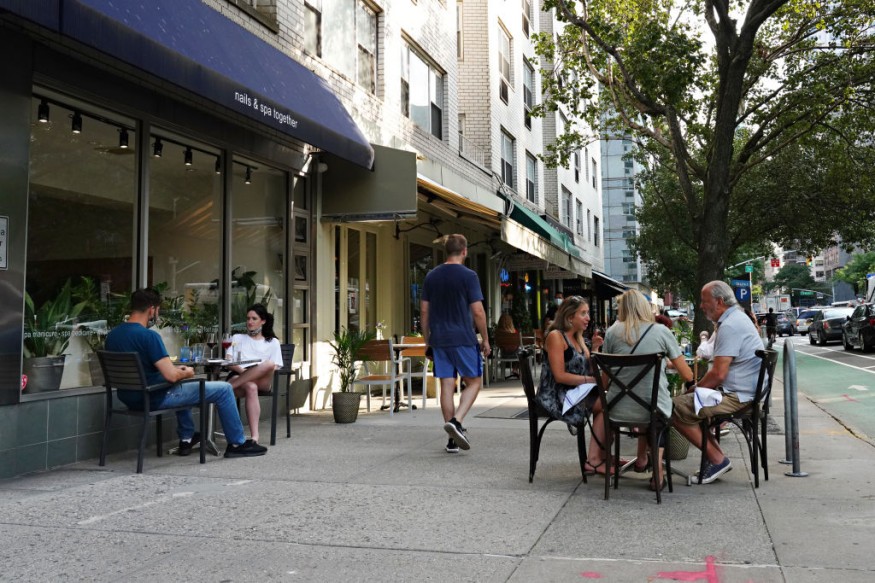Restaurants are facing a new wave of restrictions as COVID-19 cases in the United States hit a record high.
According to CNBC, the profound effects of COVID-19 may pose another obstacle for restaurants and other eating establishments as the new cases hit a record high the past few days.
View this post on InstagramA grim milestone. The number of new daily coronavirus cases recorded in the U.S. surpassed 100,000 for the time, according to a tally by Johns Hopkins University. The data showed 102,831 new Covid-19 infections were recorded on Wednesday, up from 91,530 cases on Election Day. The data also showed that 1,097 deaths were recorded Wednesday, lower than the 1,134 deaths reported the previous day. In total, the coronavirus has killed 233,734 people in the U.S. The new daily record comes after data showed a soaring number of hospitalizations due to the virus in many states, with the surge most pronounced in the Midwest and Southwest. Link in bio. A post shared by CNBC (@cnbc) on Nov 5, 2020 at 11:02am PST
The New York Times database revealed that new daily COVID-19 cases reached 88,521 as of Oct. 30 and 121,504 new cases followed this on Nov. 5.
This data translates to an average of 96,275 cases per day recorded over the past week, which shows an increase of 54 percent from the average two weeks earlier.
As of Friday morning, the U.S. has recorded more than 9.6 million people infected with COVID-19, with at least 235,300 deaths.
As a result, the recent surge in COVID-19 cases has led some areas of the nation to reimpose tighter restrictions on restaurants and other food establishments.
Beginning Friday, indoor eating is once more banned at Chicago restaurants. Meanwhile, Denver implemented a 25 percent seating capacity, which shows a decrease from the previous 50 percent capacity.
Read also article : Popular Comfort Food To Get You Through Election Night 2020
Difficulty In Sales Rebound
Many restaurants attributed the rebound in their sales to the previous relaxation of restrictions. However, the recent rise in new daily COVID-19 cases poses uncertainty and makes forecasting their recovery even more difficult.
Texas Roadhouse and Darden Restaurants, which are full-service restaurants, also directly link the resumption of sales to the relaxation of restaurant restrictions.
Starbucks announced that 63 percent of its U.S. cafes are currently under restricted seating. The company expects to return to its same-store gross sales development by the second quarter in March. But that forecast was based on full cafe seating and work hours.

Also, restaurants that have relied on patio dining will most likely take a hit, especially with the incoming cold weather. A survey conducted by a U.S. financial institution revealed that 60 degrees Fahrenheit is the cut-off temperature for most diners.
For example, the Cheesecake Manufacturing facility's reliance on patio dining led to its inventory downgrade in August.
On the other hand, the new restrictions may seem to be simpler for fast-food establishments. The perfect example is Yum Manufacturers' Taco Bell, which reported 30 million extra clients ordering their meals through the drive-thru.
Yum CEO David Gibbs stated that they acknowledge that they are in a fluid environment. But it is not an environment where predictions can be made for 2021.
He further explained that they have full trust in their team based on how they recovered. He firmly believes that they will be able to pivot to whatever is thrown their way.
There are also those food establishments that seem to thrive amid the pandemic and don't see any issues whatsoever with the new restrictions.
One of the few establishments that continues to stand its ground is Wingstop. Despite its dining rooms remaining closed for over seven months, they have seen a sales surge during the crisis.
This is all possible since they relied on tech investments and popularity with loyal customers' food delivery orders.
Related article : Kitchen Hinching Could Result in Dangerous Cleaning Techniques
© copyright 2024 Food World News, a property of HNGN Inc. All rights reserved. Use of this website constitutes acceptance of our terms and conditions of use and privacy policy.









